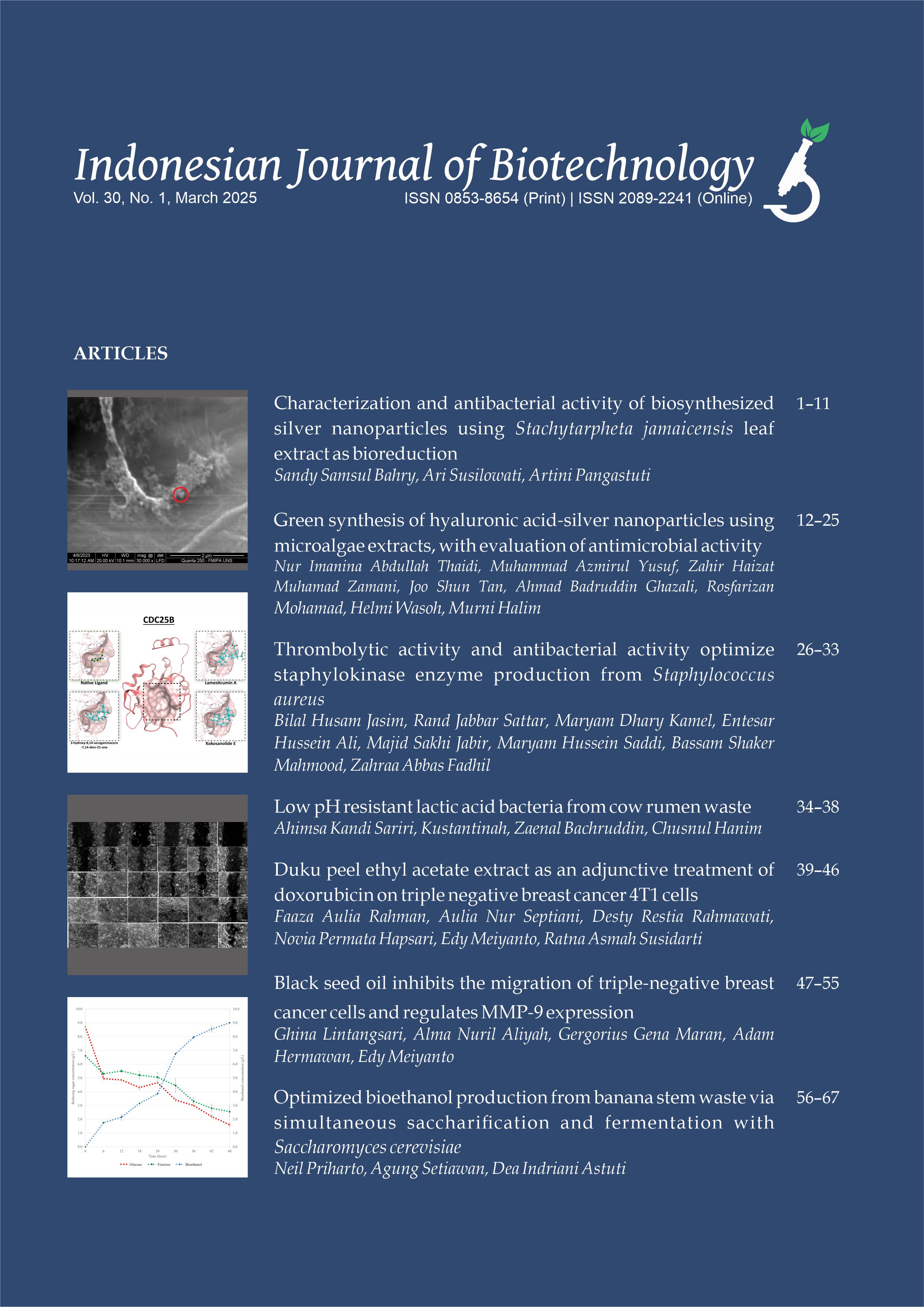Black seed oil inhibits the migration of triple‐negative breast cancer cells and regulates MMP‐9 expression
Ghina Lintangsari(1), Alma Nuril Aliyah(2), Gergorius Gena Maran(3), Adam Hermawan(4*), Edy Meiyanto(5)
(1) Cancer Chemoprevention Research Center, Faculty of Pharmacy, Universitas Gadjah Mada Sekip Utara II, 55281 Yogyakarta, Indonesia
(2) Cancer Chemoprevention Research Center, Faculty of Pharmacy, Universitas Gadjah Mada Sekip Utara II, 55281 Yogyakarta, Indonesia
(3) Cancer Chemoprevention Research Center, Faculty of Pharmacy, Universitas Gadjah Mada Sekip Utara II, 55281 Yogyakarta, Indonesia
(4) Cancer Chemoprevention Research Center, Faculty of Pharmacy, Universitas Gadjah Mada Sekip Utara II, 55281 Yogyakarta, Indonesia; Laboratory of Macromolecular Engineering, Department of Pharmaceutical Chemistry, Faculty of Pharmacy, Universitas Gadjah Mada Sekip Utara II, 55281 Yogyakarta, Indonesia
(5) Cancer Chemoprevention Research Center, Faculty of Pharmacy, Universitas Gadjah Mada Sekip Utara II, 55281 Yogyakarta, Indonesia; Laboratory of Macromolecular Engineering, Department of Pharmaceutical Chemistry, Faculty of Pharmacy, Universitas Gadjah Mada Sekip Utara II, 55281 Yogyakarta, Indonesia
(*) Corresponding Author
Abstract
Black seed (Nigella sativa L.) is well known for its pharmacological properties, particularly its anticancer activity, with previous studies demonstrating its cytotoxic effects on several cell lines, such as A‐549, DLD‐1, MDA‐MB231, or HCT. This study aims to investigate the effects of black seed oil (BSO) on the migratory activity of 4T1 triple‐negative breast cancer (TNBC) cells, focusing on its bioactive properties. BSO was extracted via hydro‐distillation and analyzed for its phytochemical composition using gas chromatography–mass spectrometry (GC‐MS). The cytotoxicity of BSO and doxorubicin (Dox) was assessed using the MTT assay. The effects of BSO and Dox on cell migration and matrix metalloproteinase‐9 (MMP‐9) expression were evaluated using a scratch wound‐healing assay and gelatin zymography method respectively. Additionally, intracellular reactive oxygen species (ROS) levels were measured using 2’,7’‐dichlorofluorescin diacetate (DCFDA) staining. GC‐MS analysis identified p‐cymene as a major component of BSO, along with various other bioactive compounds. BSO exhibited low toxicity toward 4T1 cells, while its combination with Dox reduced cell viability in a dose‐dependent manner. Furthermore, BSO in combination with Dox inhibited cell migration and suppressed MMP‐9 expressions in 4T1 cells. BSO treatment also led to an increase in ROS levels. In conclusion, BSO exhibits potential anticancer properties by inhibiting cell migration and downregulating MMP‐9 expression, highlighting its possible therapeutic role in TNBC treatment.
Keywords
Full Text:
PDFReferences
Ahlina FN, Nugraheni N, Salsabila IA, Haryanti S, Da’i M, Meiyanto E. 2020. Revealing the reversal effect of galangal (Alpinia galanga L.) extract against oxidative stress in metastatic breast cancer cells and normal fibroblast cells intended as a Co-chemotherapeutic and antiageing agent. Asian Pacific J. Cancer Prev. 21(1):107–117. doi:10.31557/APJCP.2020.21.1.107.
AlRajhi A, Abdelghany T, Almuhayawi M, Alruhaili M, Saddiq A, Baghdadi A, AL Jaouni S, Albasri H, Waznah M, Alraddadi F, Selim S. 2024. Effect of ozonation on the phytochemicals of black seed oil and its antimicrobial, antioxidant, antiinflammatory, and antineoplastic activities in vitro. Sci. Rep. 14:30445. doi:10.1038/s41598024811579.
AlSheddi ES, Farshori NN, AlOqail MM, Musarrat J, AlKhedhairy AA, Siddiqui MA. 2014. Cytotoxicity of Nigella sativa seed oil and extract against human lung cancer cell line. Asian Pacific J. Cancer Prev. 15(2):983–987. doi:10.7314/APJCP.2014.15.2.983.
Ali SR, Hussain ST, Ahsan SA, Shehzadi N, Ashfaq M, Bano S, Akhlaq M, Umrani JH. 2022. Black Seeds (Nigella sativa L.) kalonji: A brief review of its anticancer and anti Tumour qualities. Hamdard Med. 65(1):25–33.
Aliyah AN, Lintangsari G, Maran GG, Hermawan A, Meiyanto E. 2021. Cinnamon oil as a cochemotherapy agent through inhibition of cell migration and MMP9 expression on 4T1 cells. J. Complement. Integr. Med. 19(4):921–928. doi:10.1515/jcim 20200165.
Balahbib A, El Omari N, Hachlafi NE, Lakhdar F, El Menyiy N, Salhi N, Mrabti HN, Bakrim S, Zengin G, Bouyahya A. 2021. Health beneficial and pharmacological properties of p-cymene. Food Chem. Toxicol. 153:112259. doi:10.1016/j.fct.2021.112259.
BenkaciAli F, Baaliouamer A, Meklati BY, Chemat F. 2007. Chemical composition of seed essential oils from Algerian Nigella sativa extracted by microwave and hydrodistillation. Flavour Fragr. J. 22(2):148– 153. doi:10.1002/ffj.1773.
Bicas JL, NeriNuma IA, Ruiz AL, De Carvalho JE, Pastore GM. 2011. Evaluation of the antioxidant and antiproliferative potential of bioflavors. Food Chem. Toxicol. 49(7):1610–1615. doi:10.1016/j.fct.2011.04.012.
Burits M, Bucar F. 2000. Antioxidant activity of Nigella sativa essential oil. Phyther. Res. 14(5):323–328. doi:10.1002/10991573(200008)14:5<323::AIDPTR621>3.0.CO;2Q.
De Lima VT, Vieira MC, Kassuya CA, Cardoso CA, Alves JM, Foglio MA, De Carvalho JE, Formagio AS. 2014. Chemical composition and free radical-scavenging, anticancer and antiinflammatory activities of the essential oil from Ocimum kilimandscharicum. Phytomedicine 21(11):1298–1302. doi:10.1016/j.phymed.2014.07.004.
Elkady AI, Hussein RA, ElAssouli SM. 2015. Mechanism of action of Nigella sativa on human colon cancer cells: The suppression of AP1 and NFκB transcription factors and the induction of cytoprotective genes. Asian Pacific J. Cancer Prev. 16(17):7943– 7957. doi:10.7314/APJCP.2015.16.17.7943.
Gautam J, Banskota S, Lee H, Lee YJ, Jeon YH, Kim JA, Jeong BS. 2018. Downregulation of cathepsin S and matrix metalloproteinase9 via Src, a nonreceptor tyrosine kinase, suppresses triplenegative breast cancer growth and metastasis. Exp. Mol. Med. 50(9):1–14. doi:10.1038/s1227601801359.
Harzallah HJ. 2012. Chemical composition, antibacterial and antifungal properties of Tunisian Nigella sativa fixed oil. African J. Microbiol. Res. 6(22):4675– 4679. doi:10.5897/ajmr11.1073.
Hosseinzadeh L, Soheili S, Ghiasvand N, Ahmadi F, Shokoohinia Y. 2018. Fatty acid mixtures from Nigella sativa protects PC12 cells from oxidative stress and apoptosis induced by doxorubicin. Pharm. Sci. 24(1):15–22. doi:10.15171/PS.2018.04.
Islam MT, Khan MR, Mishra SK. 2019. An updated literaturebased review: phytochemistry, pharmacology and therapeutic promises of Nigella sativa L. Orient. Pharm. Exp. Med. 19(2):115–129. doi:10.1007/s13596019003633.
JabłońskaTrypuć A, Matejczyk M, and SR. 2016. Matrix metalloproteinases (MMPs), the main extracellular matrix (ECM) enzymes in collagen degradation, as a target for anticancer drugs. J. Enzyme Inhib. Med. Chem. 31(sup1):177–183. doi:10.3109/14756366.2016.1161620.
Kang E, Lee DH, Jung YJ, Shin SY, Koh D, Lee YH. 2016. αPinene inhibits tumor invasion through down-regulation of nuclear factor (NF)κBregulated matrix metalloproteinase9 gene expression in MDAMB 231 human breast cancer cells. Appl. Biol. Chem. 59(4):511–516. doi:10.1007/s1376501601756.
Karagiannis GS, Condeelis JS, Oktay MH. 2018. Chemotherapy-induced metastasis: Mechanisms and translational opportunities. Clin. Exp. Metastasis 35(4):269–284. doi:10.1007/s105850179870x.
Kazemi M. 2014. Phytochemical composition, antioxidant, antiinflammatory and antimicrobial activity of Nigella sativa L. essential oil. J. Essent. OilBearing Plants 17(5):1002–1011. doi:10.1080/0972060X.2014.914857.
Kumari S, Badana AK, Murali Mohan G, Shailender G, Malla RR. 2018. Reactive oxygen species: A key constituent in cancer survival. Biomark. Insights 13:1177271918755391. doi:10.1177/1177271918755391.
Larasati YA, YonedaKato N, Nakamae I, Yokoyama T, Meiyanto E, Kato JY. 2018. Curcumin targets multiple enzymes involved in the ROS metabolic pathway to suppress tumor cell growth. Sci. Rep. 8(1):1–13. doi:10.1038/s41598018201796.
Liao Z, Chua D, Tan NS. 2019. Reactive oxygen species: A volatile driver of field cancerization and metastasis. Mol. Cancer 18:65. doi:10.1186/s129430190961y.
Ma J, Peng C. 2024. Nigella sativa plant extract inhibits the proliferation of MDAMB231 breast cancer cells via apoptosis and cell cycle arrest. Bangladesh J. Pharmacol. 19(1):29–38. doi:10.3329/bjp.v19i1.71069.
Mahmoudvand H, Sepahvand A, Jahanbakhsh S, Ezatpour B, Ayatollahi Mousavi SA. 2014. Evaluation of antifungal activities of the essential oil and various extracts of Nigella sativa and its main component, thymoquinone against pathogenic dermatophyte strains. J. Med. Mycol. 24(4):e155–61. doi:10.1016/j.mycmed.2014.06.048.
MarioliSapsakou GK, Kourti M. 2021. Targeting production of reactive oxygen species as an anticancer strategy. Anticancer Res. 41(12):5881–5902. doi:10.21873/anticanres.15408.
Mehraj T, Elkanayati RM, Farooq I, Mir TM. 2022. Chapter 4 A review of Nigella sativa and its active principles as anticancer agents. Elsevier. p. 91–118.
Mileo AM, Miccadei S. 2016. Polyphenols as modulator of oxidative stress in cancer disease: New therapeutic strategies. Oxid. Med. Cell. Longev. 2016:6475624. doi:10.1155/2016/6475624.
Mohammed SJ, Amin HH, Aziz SB, Sha AM, Hassan S, Abdul Aziz JM, Rahman HS. 2019. Structural characterization, antimicrobial activity, and in vitro cytotoxicity effect of black seed oil. Evidence-based Complement. Altern. Med. 2019:6515671. doi:10.1155/2019/6515671.
Mollazadeh H, Afshari AR, Hosseinzadeh H. 2017. Review on the potential therapeutic roles of Nigella sativa in the treatment of patients with cancer: Involvement of apoptosis: Black cumin and cancer. J. Pharmacopuncture 20(3):158–172. doi:10.3831/KPI.2017.20.019.
Mori K, Uchida T, Yoshie T, Mizote Y, Ishikawa F, Katsuyama M, Shibanuma M. 2019. A mitochondrial ROS pathway controls matrix metalloproteinase 9 levels and invasive properties in RAS-activated cancer cells. FEBS J. 286(3):459–478. doi:10.1111/febs.14671.
Mukhtar H, Qureshi AS, Anwar F, Mumtaz MW, Marcu M. 2019. Nigella sativa L. seed and seed oil: potential sources of high-value components for development of functional foods and nutraceuticals/pharmaceuticals. J. Essent. Oil Res. 31(3):171– 183. doi:10.1080/10412905.2018.1562388.
Çınar r, Gıdık B, Dirican E. 2024. Determination of anticancer effects of Nigella sativa seed oil on MCF7 breast and AGS gastric cancer cells. Molecular Biology Reports 51(1):491. doi:10.1007/s11033024 094531.
Nurrachma MY, Maran GG, Putri NB, Esti YF, Hermawan A, Meiyanto E, Jenie RI. 2020. Fingerroot (Boesenbergia pandurata) extract inhibits proliferation and migration of 4T1 metastatic breast cancer cells. Indones. J. Cancer Chemoprevention 11(3):141–150. doi:10.14499/indonesianjcanchemoprev11iss3pp103 114.
Piskounova E, Agathocleous M, Murphy MM, Hu Z, Huddlestun SE, Zhao Z, Leitch AM, Johnson TM, DeBerardinis RJ, Morrison SJ. 2015. Oxidative stress inhibits distant metastasis by human melanoma cells. Nature 527(7577):186–191. doi:10.1038/nature15726.
amadani RD, Utomo RY, Hermawan A, Meiyanto E. 2018. Curcumin analog pentagamaboronon 0-sorbitol inhibits cell migration activity of triplenegative breast cancer cell line. Indones. J. Cancer Chemoprevention 9(3):126–133. doi:10.14499/indonesianjcanchemoprev9iss3pp126 133.
Reczek CR, Chandel NS. 2017. The two faces of reactive oxygen species in cancer. Annu. Rev. Cancer Biol. 1:79–98. doi:10.1146/annurevcancerbio 041916065808.
Shokri H. 2016. A review on the inhibitory potential of Nigella sativa against pathogenic and toxigenic fungi. Avicenna J. Phytomed. 6(1):21–33.
Toth M, Sohail A, Fridman R. 2012. Assessment of gelatinases (MMP2 and MMP9) by gelatin zymography. Methods Mol. Biol. 878:121–135. doi:10.1007/978 1617798542_8.
Usmani A, Mishra A, Arshad M, Jafri A. 2019. Development and evaluation of doxorubicin self nanoemulsifying drug delivery system with Nigella sativa oil against human hepatocellular carcinoma. Artif. Cells, Nanomedicine Biotechnol. 47(1):933–944. doi:10.1080/21691401.2019.1581791.
Vermot A, PetitHärtlein I, Smith SM, Fieschi F. 2021. NADPH oxidases (Nox): An overview from discovery, molecular mechanisms to physiology and pathology. Antioxidants 10(6):890. doi:10.3390/antiox10060890.
Wisdom KM, Adebowale K, Chang J, Lee JY, Nam S, Desai R, Rossen NS, Rafat M, West RB, Hodgson L, Chaudhuri O. 2018. Matrix mechanical plasticity regulates cancer cell migration through confining microenvironments. Nat. Commun. 9(1):4144. doi:10.1038/s4146701806641z.
Xu Q, Li M, Yang M, Yang J, Xie J, Lu X, Wang F, Chen W. 2018. α-pinene regulates miR221 and induces G2/M phase cell cycle arrest in human hepatocellular carcinoma cells. Biosci. Rep. 38(6):BSR20180980. doi:10.1042/BSR20180980.
Zeller KS, Riaz A, Sarve H, Li J, Tengholm A, Johansson S. 2013. The role of mechanical force and ROS in integrindependent signals. PLoS One 8(5):e64897. doi:10.1371/journal.pone.0064897.
Zhang Y, Fan Y, Huang S, Wang G, Han R, Lei F, Luo A, Jing X, Zhao L, Gu S, Zhao X. 2018. Thymoquinone inhibits the metastasis of renal cell cancer cells by inducing autophagy via AMPK/mTOR signaling pathway. Cancer Sci. 109(12):3865–3873. doi:10.1111/cas.13808.
Zhu H, Sarkar S, Scott L, Danelisen I, Trush M, Jia Z, Li YR. 2016. Doxorubicin redox biology: Redox cycling, topoisomerase inhibition, and oxidative stress. React. Oxyg. Species p. 189–198. doi:10.20455/ros.2016.835.
Article Metrics
Refbacks
- There are currently no refbacks.
Copyright (c) 2025 The Author(s)

This work is licensed under a Creative Commons Attribution-ShareAlike 4.0 International License.









